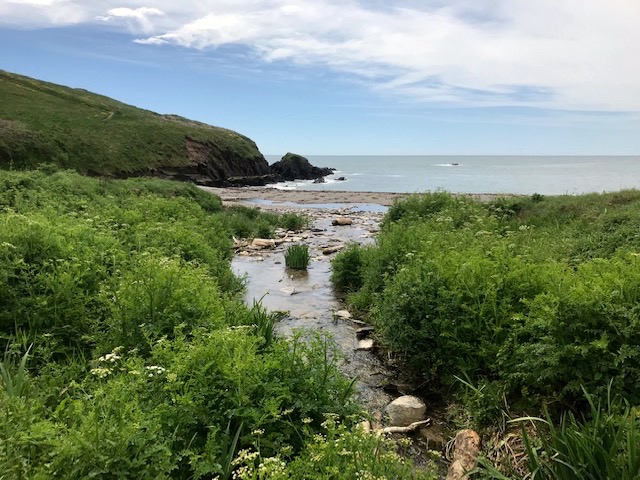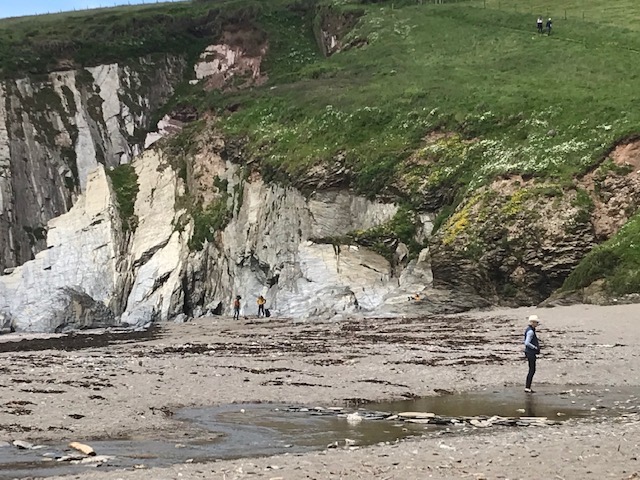
No west country holiday is complete without a swim in the sea. As a weak swimmer I rarely goes out of my depth. The ideal spot needs to have a gradual incline, without strong tides, sheltered and preferably not crowded. I found such a place here, at Ayrmer cove. A grey shingle beach where a stream meets the sea, defined either side by cliffs composed of huge slate slabs dating from the Devonian era, formed between 395 – 345 million years ago.

The sublime joy of letting go, diving then floating, eyes closed, limbs akimbo, bobbing about on the lapping waters of the little bay. Then, about to wade ashore, re-opening eyes to the wide blue yonder, there’s a brimstone butterfly riding the breeze just above my head, a happy symbol of this sensual interlude.

Once again thanks are due to the National Trust for owning and maintaining such a place. (On leaving we passed a van’s worth worth of cleared flotsam and jetsam stacked ready for collection). The 20’ walk from the Trust’s landscaped car park on a cul-de-sac outside Ringmore village and the lack of any facilities might also explain its quiet unspoilt state. A few dog walkers, occasional passing ramblers on the coastal trail, and a handful of bathers under the cliffs. Just perfect.

We’d taken one track down the valley, between banks of flower filled hedges, and returned via the field path running parallel on the other side of the little valley. Cows with calves at foot grazed contentedly, hock high in lush meadows brightened by kingcup and other marsh plants. We ambled with our gear, entering cooling woodland shade awash with ferns, before the final ascent back to Ringmore.

This must be one of the prettiest of Devon’s ancient villages, with many a thatched cottage proudly kept and no street lighting along its narrow circling thoroughfares more like paths than roads. The ‘Journey’s End’ pub enjoys a great reputation for its evening meals (The chef and his family live permanently on site, which might help explain why) It’s named after the seminal play set on the Western front in WW1, first performed in London’s West End in 1929. Certainly proved a fitting place to complete our lovely sea blessed outing today.

Based on his own experience as an officer in the conflict, R.C.Sheriff (1896-1975) wrote ‘Journey’s End’ while staying on holiday here and the New Inn (already ancient) was subsequently renamed in its honour. An archetypal old building of low beams, nooks and crannies I fancied it oddly reflective of the officers’ mess in the trenches where the play’s action is set. I wondered if, back in the 1920’s, it might have put Sherriff in mind of that place he knew so intimately and could evoke so powerfully through drama.

Histories of past conflicts affected the parish church too, or rather one of its rectors. All Hallows is a venerable building too, though much restored. In 1637 a new incumbent was appointed Rector here. William Lane was a staunch Royalist who, when civil war broke out in England in 1642, set to raising and training a village militia for King Charles’ cause. In retaliation for his guerrilla action in the area a detachment of troops sailed up from Parliamentary HQ in Plymouth, landed at Aymer Cove, marched up the valley, set fire to the Rectory and arrested Reverend Lane’s two eldest sons. The man himself spent the next few weeks hiding in the Church Tower, aided and supported by loyal parishioners, before making his escape to France. Loved this story for its parallels with the other tales of Royalist rebellion and rout we’d encountered on this holiday, from Boscobel to Colyton….And it doesn’t end there.
